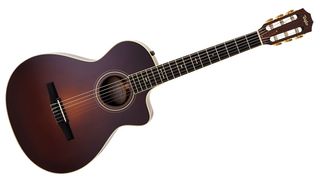
This good build quality translates to good playability, easy enough for beginners, and can also handle advanced techniques used by experienced musicians. But thanks to Yamaha's penchant for build quality and attention to detail, they have made a seemingly ordinary instrument, into a consistent market favorite. It just bears the expected characteristics of a classical guitar, including the body shape, nut width, scale length, and string height. On paper, it doesn't offer anything out of the ordinary. It gets the most recommendations from teachers and continues to be the perennial classical guitar for novices. The Yamaha C40 has been the best classical guitar for beginners for decades, and rightly so. The Best Classical & Nylon String Guitars - 2023.05Īt publication time this was the Highest Rated Nylon String Guitar Under $200.

Other nylon string guitar variants are meant to appeal to those who want the tone and soft feel of nylon strings, minus the bulk and traditional look of classical and flamenco guitars. Whether you are a beginner or you're looking to seriously study classical or flamenco music, or you just want to expand into nylon string territory, these market favorites will be a good fit.Ĭlassical guitars retain a very specific profile and specifications that fit the classical music genre, making them the default guitar for many music conservatory teachers and students.įlamenco guitars have a slightly different design, meant to better handle more aggressive and percussive styles of playing. And in the hands of professionals, they can be very sonically rich and complex instruments. The nylon string guitar is a beginner-friendly choice, because of how easy the strings are to play. Here we showcase the best nylon string guitars that cover all these types, so you can choose one with the voicing, body shape, and playing feel that you prefer. But some manufacturers have been breaking out of the mold, offering crossover nylon string guitars that are more relevant to modern gigging and music styles. With the thinnest E bring it back in the opposite direction and tuck it under the B string.When you're looking for the best nylon string guitar, the most common options are traditional flamenco and classical guitars.

Here is a close-up showing how the tail is tucked in. On the next knot take the tale and tuck it in. Repeat this process again with the next string. Here is a close up of the knot, with the string resting on the saddle. Now pull on the longer part to make the knot tight. Loop the tail around the bottom of the string and back on itself.įeed the tail under itself and pull the slack through.Īgain, feed the tail under itself a second time. Take the tail, bend it back over the bridge and to the right of the string. You will need around 3 inches pushed through. Push the string through (from the sound hole side) the hole in the bridge.

Take note of the system used to identify each string and what order they need to go in. Sort the new strings, ready for installation. If you have broken one, this is another indication that you need to change all 6 of them, so that you get an even tone. You may also find that your fingers smell funny after you have played. This causes the string to vibrate unevenly and so not give a good ring when plucked.
Nylon string classical guitar skin#
In between the windings, the wrapped strings get gunked up with dead skin cells, oil from your fingers, dust and lots of other yucky things.

They can also turn black due to the silver oxidising, again another indication that they need changing. These are usually silver-plated copper, so if the copper is starting to show through, this is a good indication that they need changing. The bass strings (the 3 ones that have a silver winding wrapped around them) show you more obviously when they are old and need changing. You will find that when they get old, it will be difficult to keep in tune and they may snap. This makes it more prone to snapping as it causes micro-fractures in them. The nylon, when under tension, starts to stretch. Guitars need to have their strings changed regularly to get the best tone and playability. Classical guitars have 6 nylon strings although 3 of them look like metal (these have a nylon core and are wrapped in silver to make them thicker).


 0 kommentar(er)
0 kommentar(er)
